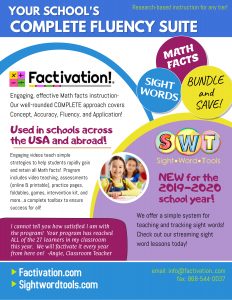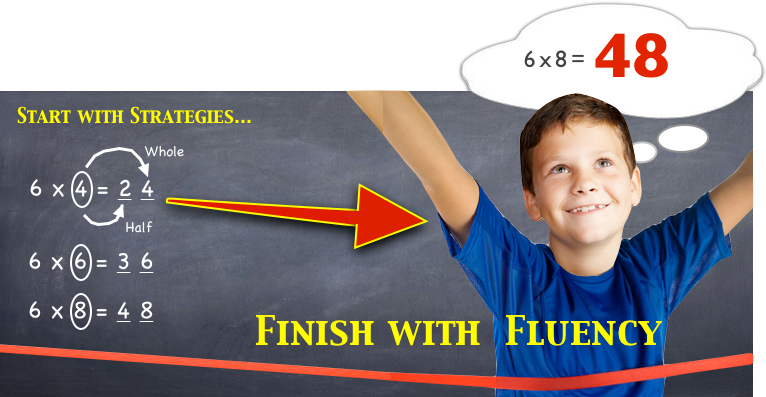03 Nov Math fact mastery: Reaching the fluency finish line
STEP 1: Start with Strategies to Create a Mental Hook
Why use strategies (like Rule, Trick, Chant, and Connection™) to teach Math facts rather than just having students memorize in a traditional rote manner? The Factivation!® strategies utilize existing schema. They apply meaning to each fact, thereby increasing a students’ ability to recall the product.
“A schema is composed of organized personal background knowledge, and it acts as a filing system that has been set up to organize past experiences and interpret future experiences…Think of this background information as a hook on which to hang new information or a file folder into which new information can be integrated.”
How to Teach Balanced Reading and Writing, Bonnie Burns, 2006.
The purpose of the strategies is to quickly familiarize students with each fact group and to provide a system of support, allowing students to accurately reach the correct product, even in the initial stages of learning. The strategies also provide a means of self-checking as students are transitioning into fact fluency. A student may look at 4×6, for example, and think “24”. He/she can check for accuracy by applying the Half-Whole Multiplication trick. Successful fact instruction emphasizes operational understanding and accuracy first, then fluency.
Note: Activities that develop a thorough understanding of the concept of Multiplication should be an integral part of fact instruction for younger learners who have not yet established this foundational understanding. >>More
Sample Concept Building Activities:
Concept Builder 6.1 (Lesson 6)
Fact Building- Concept Mats and Arrays (Lesson 6)
STEP 2: Move Beyond the Strategies & Build Accuracy
Here are some practical suggestions for moving beyond the strategies (initial learning) and into accuracy with Multiplication facts.
Class Attention Getters- Create Chant/Fact Associations
The facts in the Chant group (Lessons 6, 7, 8) have typically been the more difficult facts when it comes to mastery: 7×3, 8×4, and 7×8 are but a few included in this group. However, the Chant strategy helps students apply meaning to these facts, making for much easier recall than learning the products by rote memorization.
The Multiplication facts covered in Lesson 6, for example, are 7×6, 3×4, and 7×8. The commutative property is reinforced throughout this and all lessons, so students are also learning 6×7, 4×3, and 8×7. For students to see 6×7 and have immediate recall of the product, 42, an association must have been made between the chant and the fact in isolation. The best way to create this association is to present a visual representation of the fact while the chant is recited aloud. Teachers are encouraged to use the Factivation chants as their daily class-attention getters. The method described below, coupled with multiple viewings of the Factivation videos, will help create the necessary associations between the chants and their corresponding facts.
Introducing the Multiplication Chants During the First Week of School
Tell students you’re going to teach them an attention-getter that you’ll be using in class all week. Every time you need their attention, you’ll be getting it in the same way.
Teacher: Class, I will say the first part of the chant, “Seven beetles, six legs walking to the Zoo…”. Then you’ll respond like this, “How many legs? Forty-Two!” Now, let me show you the Multiplication fact that goes with this chant.Teacher holds up a pre-made poster of 7x6=42 and 6x7=42 or simply writes the facts prominently on the board (not to be erased for the remainder of the week).
Teacher: Class let’s practice our attention-getter. While we recite it, I want you to look at the fact as I point to the factors and product.
(Teacher and students recite the chant. Teacher draws students’ attention to the visual representation of the fact by pointing or just standing nearby.) Throughout the remainder of the day/week, this chant is used as the class attention-getter and each time, the teacher either stands by the facts or points to the facts while students are saying the chant. After a few days, cover up (or erase) the product, 42. Repeat the procedure so students can start associating the facts, 7×6 and 6×7 (without the product visible) to the “7 Beetles” Chant. Teach students that they can think ahead to the end of the chant and quickly “grab” the answer. You can explain it like this…
Teacher: All week, we’ve been reciting the “7 Beetles” Chant for our class attention-getter and I’ve pointed out numerous times that this chant went with 7×6 and 6×7, but I don’t need to recite the whole chant to get the answer. I now know that anytime I see 7×6 or 6×7, I can just think about the last number in that chant, the number of legs. Class, how many legs? (Students respond 42.) Yes, I remember the number of beetles’ legs is 42, so I know that’s the product of 7×6 and 6×7. Class, what is the product of 7×6 and 6×7? (Students respond 42.)
Revisit the posters or board several times on Friday asking students for the product without reciting the chant. In this way, we can use the chants to create a bridge to fluency. For visual learners, seeing the fact (while hearing the chant) is imperative. The Factivation!® videos use many visual elements to establish this association as well.
After viewing the Lesson Six video and practicing the chant using the prescribed method above, 7 and 6, when seen together, trigger the “7 Beetles” chant and students can quickly recall the product- 42. The reason that flashcards, electronic flashcards, and many internet games are not very effective is because seeing/hearing 7×6 ,6×7, etc. does not trigger anything in the student’s mind. A schema for that information was never established! For those methods to be effective, Multiplication facts need to be made meaningful first, which is exactly what Factivation!® does through the strategies. See how the Factivation!® strategies aid in recall of the corresponding Division facts.
Repeat for 3×4 and 4×3 the following week. Use the same procedure the third week for 7×8 and 8×7.
The above method can be used from the first week of school even with third graders and 6×7, 7×6 can be taught even before Multiplication instruction officially begins. Using the chants as your daily class attention getters using the method described above takes just a few minutes a day, but will fully prepare students for the learning that is to take place in Lessons 6-8.
STEP 3: Move from Accurate Recall to Rapid Recall (Automaticity) with Consistent Practice/Review
The strategies help students to be accurate when answering Multiplication problems. Once students are comfortable with the strategy, it’s time to move into fluency building. We suggest two methods for building fluency with Math facts: 1) targeted paper/pencil practice, and 2) independent online practice. A combination of both is recommended (see below).
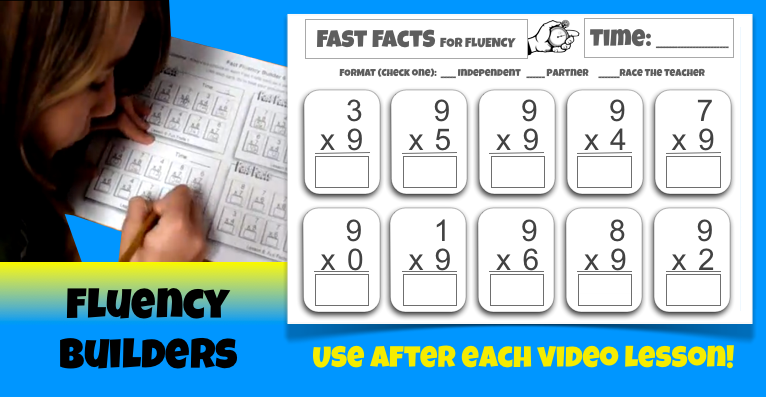
Fluency Builder Activities with Each Factivation!® Lesson:
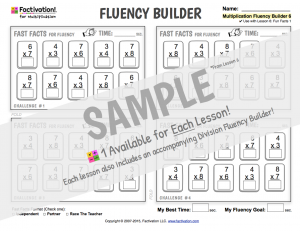 A power-printable within the Factivation!® program, the Fluency Builder (which accompanies each lessson) should be done daily because it helps students move beyond relying on the strategies and into the next phase of their fact development: fluency. (“When referring to the ‘basic facts’ [fluency] means automaticity with understanding.” – Quote from Glastonbury Public Schools website.) This printable provides repetitive practice with facts from the current lesson and can be done in under 10 minutes as a partner activity or in a “Race the Teacher” format which students love. LEARN MORE ABOUT FACTIVATION!® FLUENCY BUILDERS
A power-printable within the Factivation!® program, the Fluency Builder (which accompanies each lessson) should be done daily because it helps students move beyond relying on the strategies and into the next phase of their fact development: fluency. (“When referring to the ‘basic facts’ [fluency] means automaticity with understanding.” – Quote from Glastonbury Public Schools website.) This printable provides repetitive practice with facts from the current lesson and can be done in under 10 minutes as a partner activity or in a “Race the Teacher” format which students love. LEARN MORE ABOUT FACTIVATION!® FLUENCY BUILDERS
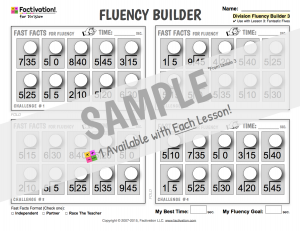 “Race the Teacher” Fluency Builder Game Instructions-
“Race the Teacher” Fluency Builder Game Instructions-
- Distribute Fluency Builders for the current lesson and have students fold paper into fourths.
- Begin with the first section and tell students you will give them a 7-second head start. Their goal is to try to beat you. When finished with that section, check it together and move on.
- Go to second section and give a 5-second head start and repeat the procedure above.
- Go to the third section and give a 3-second head start.
- On the last section. watch students’ excitement as they have an “all-out” race against the teacher.
SEE MORE FLUENCY BUILDER ACTIVITIES
Student Fact Lab: Fluency Games and Timed Challenges
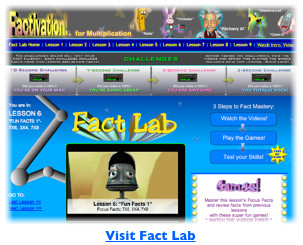 We also recommend making use of the Student Fact Lab where students can play practice games designed to build fluency with current facts, while reviewing previously-learned facts. Students can use the timed challenges at the top to quickly build fact fluency, starting with the 10-second challenge and making their way down to the 3-second challenge.
We also recommend making use of the Student Fact Lab where students can play practice games designed to build fluency with current facts, while reviewing previously-learned facts. Students can use the timed challenges at the top to quickly build fact fluency, starting with the 10-second challenge and making their way down to the 3-second challenge.
Please visit our blog for more ideas on how to make the most of your Factivation!® program! We are committed to providing teachers/parents with engaging online resources to ensure Math fact mastery!
